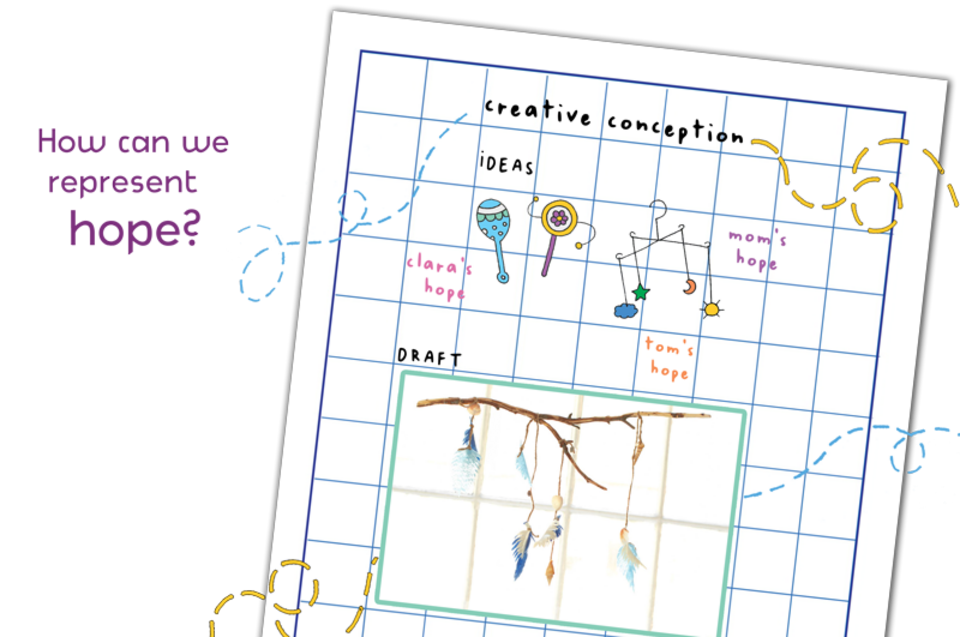
The mobile of hope (Part 1)
| Objective: To plan the creation of a mobile made up of hopeful messages! |
Duration: 60 to 90 minutes
Material:
A sheet of paper
Pencils and eraser
- Coloured pencils and markers
Instructions:
Mobiles are sculptures made of sticks and light, colourful objects hanging from strings and moving gently in a delicate balance. They can be found hanging above newborns’ cradles or in museums. Your mission will be to create a mobile uniting your hopes and those of your loved ones!
...
- Go look for hopes. The very first step of your creative project is to figure out the hopes that will compose your mobile, by asking yourself what your own hopes are and by interviewing your loved ones, in person or over the phone. Hmm... but what is hope? To inspire your own thinking and that of the people with whom you are communicating, think back to the definition of hope you offered in the Idea stretching activity.
- Write down the hopes. To collect the hopes that will make up your mobile, ask everyone you interview to write a short description of their hope on a slip of paper. For those you can't see in person, ask them to take a photo of the paper slip and send it to you so you can transcribe it and add it to your mobile. If you have a printer, you can also print it out!
- Prepare a conception sheet. To organize your ideas, prepare a conception sheet by drawing a horizontal line to separate it into two equal rectangles. In the top rectangle write "ideas" and in the bottom rectangle write "draft."
- Think about your first ideas. Think about how you could arrange the hopes to create a beautiful mobile, that will represent hope. For each paper slip, think of colours, designs or objects that could go with it. Brainstorm in the "ideas" section of your sheet, letting your imagination run wild!
- Sketch your ideas. Now that you've got a bunch of great ideas, it's time to see what they look like! In the “draft” area of your sheet, make a sketch of your mobile. This will allow you to test your ideas and change them if necessary before you put it all together. You'll find that you'll have lots of new ideas as you start to create!
That's all for now! Don't forget that this activity is only the first part of your creative project! You can start the second part—Creative Construction—right after this one or after you've done the Philosophical Picnic, but we recommend that you at least take a break. You've earned it!
...
Bonus: Did you know there is a verb derived from the word “mobile”? To mobilize is to prepare for action, especially in a vigorous way. Can hope itself mobilize us? Maybe we could say that hope helps us mobilize our energy to act so as to bring about what we would like to see happen. For example, the hope of preserving the environment may mobilize a group of citizens to come together to clean up a forest. So to take your creation to the next level, you can add "mobilizations" to your mobile, i.e. actions to be taken to make some of the hopes contained in the mobile come true. For example, if one hope is “to remain healthy,” the corresponding mobilization could be “buy less candy!” These mobilizations can be written on paper slips or represented by objects. Finally, think about the following questions: Is hope necessary for action? Or, conversely, do you think that hoping is too passive and it is better to act? Why or why not? |

| Tricks for tots: Instead of asking your friends and family to write about their hopes, get together with them to draw things that express hope. For example, you can draw a character who is persevering despite setbacks, or a beautiful sunrise to show that there is always something to be happy about, even when life isn't going well. You can then hang these drawings as part of your mobile! Think about these few questions: What gives you hope in difficult times? Is it true that "while there is life, there is hope"? Why or why not? |
| Tips for teens: According to the German philosopher Arthur Schopenhauer, hope is a double-edged concept. On the one hand, it can help us to think and act to achieve our goals. What’s more, by hoping for something positive, we also have the possibility of feeling some pleasure in anticipation (by starting to imagine the gifts we hope to receive for our birthday, for example). On the other hand, hope can also make us suffer: Not only if what we had hoped for doesn't happen, but also, according to Schopenhauer, if the hoped-for event does happen but brings us less happiness than we expected. Hope can lead to disappointment. This disappointment can be so painful that the philosopher advocates abandoning all hope and desire in order to avoid exposing ourselves to this suffering. What do you think of all this? Can hope make us suffer? Are our hopes somehow always disappointed? Should we give up all hope to protect ourselves? Why or why not? |
Share your creative reflections by sending them via email.
Include photos of your projects and notes of your thoughts, as well as your first name and your age!


